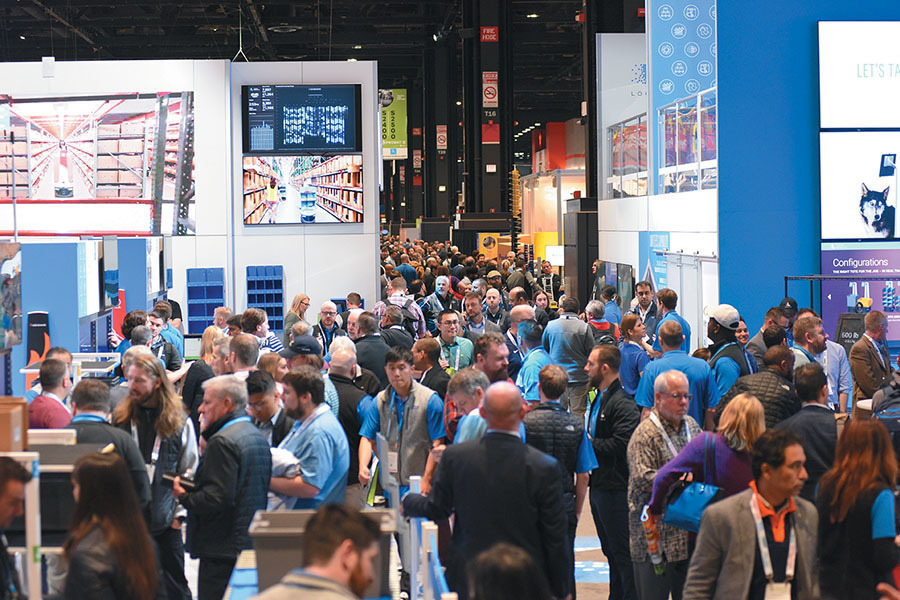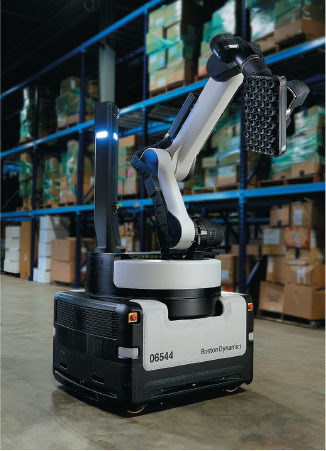Feature

 ProMat may have been a four-day event, but with more than 1,000 of the world’s leading manufacturing and supply chain solution providers exhibiting under one roof, even the most caffeinated attendees were guaranteed to miss a lot of cool innovations.
ProMat may have been a four-day event, but with more than 1,000 of the world’s leading manufacturing and supply chain solution providers exhibiting under one roof, even the most caffeinated attendees were guaranteed to miss a lot of cool innovations.
At McCormick Place in Chicago from March 20-23, ProMat attendees got to see the latest technological advances that are moving the material-handling industry forward—not to mention hands-on demonstrations, more than 150 educational seminars and four keynote speeches.
A long-distance runner might have trouble covering all the ground at ProMat, so here’s a roundup of some of the best new innovations seen at the show.
ArcBest: Vaux Freight Movement System

PHOTOS PROVIDED BY ARCBEST
A common complaint from truck drivers is that they often have dwell times of an hour or more as warehouse workers unload freight one pallet at a time, but ArcBest aims to change that with its Vaux Freight Movement System. The system allows warehouses to unload a full trailer in seconds and work the freight in minutes, according to ArcBest.
The Vaux system features a mobile freight platform that fits inside a trailer and can be configured in innumerable ways to accommodate freight of different types and sizes. A single forklift operator can unload the platform from a trailer in one swift movement, then move the platform to an optimal spot in the warehouse, alleviating congestion. Once unloaded, the platform can be situated so that forklift operators can access the pallets from any direction, significantly speeding up the put-away process. The platform also results in fewer damaged products because pallets aren’t being individually moved as often.
The Vaux software system integrates with existing warehouse management systems to orchestrate freight movement and assign tasks based on priority. Its tracking capabilities increase visibility into operations, giving warehouse supervisors real-time insights into freight movements. That enables them to make better decisions that improve dock utilization, reduce costs and boost sustainability, the company said.
Judy R. McReynolds, ArcBest’s chief executive, said the system can solve many of the “freight-handling inefficiencies” facing warehouses.
“In many of our customers’ warehouses, the traditional way of loading and unloading trailers one piece at a time is impacting their supply chains,” she said. “With Vaux, our innovation teams have developed solutions to address these challenges, allowing transformation in the way freight moves.”
Berkshire Grey/Locus Robotics: Project GreyWolf

PHOTOS PROVIDED BY LOCUS ROBOTICS
What do you get when you combine the robotics automation expertise of Berkshire Grey and Locus Robotics? The answer is Project GreyWolf, which promises to triple warehouse productivity and reduce labor requirements by 35% to 45%, according to the two companies, which announced their partnership on this project in January.
Project GreyWolf pairs the Berkshire Grey Robotic Shuttle Put Wall and the Locus Robotics Origin and Vector bots to give customers a fully automated order-fulfillment solution. The system requires minimal fixed infrastructure, reducing the space required for consolidation by 70% to 80%, according to the companies. They called Project Greywolf the industry’s first example of “cross-platform robotic automation.”
Steve Johnson, president and chief operating officer of Berkshire Grey, said Project GreyWolf will address the “growing number of customers asking for solutions that they can deploy holistically” instead of having piecemeal automation.
The companies are exploring future integrations of Berkshire Grey’s Robotic Product Sortation, Robotic Shuttle Product Sortation and Robotic Pick and Pack for eCommerce Autobagging solutions. Those integrations would enable warehouses to fully automate their autobagging and store-replenishment processes in addition to order fulfillment, increasing throughput and providing an immediate ROI, the companies said.
Boston Dynamics: Stretch Robots

PHOTO PROVIDED BY BOSTON DYNAMICS
Stretch, the new autonomous, mobile case-handling robot from Boston Dynamics, has already been deployed by companies such as Maersk, DHL and The Gap. But the robot got a much larger audience at ProMat, where it used an accordion conveyor attached to it to unload a container. Stretch also works with telescopic conveyors, according to Mike Fair, lead product manager for warehouse robotics.
“Stretch is purpose-built to be a flexible piece of automation that can seamlessly integrate into existing warehouses without a lot of extra infrastructure,” Fair said. “It’s very mobile and versatile and can just be rolled into a container. You press play, and it goes to work.”
Stretch can operate for more than a full shift on a single charge, or up to 16 hours with a high-capacity battery option. It has a vacuum gripper and advanced vision system that allow it to handle a variety of package types up to 50 pounds. Stretch also requires no SKU number pre-programming or box size information and can autonomously recover any packages that shift or fall during unloading.
Stretch’s base maneuvers in any direction and can navigate obstacles and ramps. In addition, its small footprint allows the robot to fit anywhere a pallet does. The robotic arm has the strength, speed and reach required for warehouse applications, Fair said.
David Robert, director of human-robot interaction, said ease of use is another important feature for warehouse managers dealing with high turnover.
“It’s pretty easy to learn how to use Stretch, and we designed that on purpose because the less time that somebody’s playing with the settings, the more boxes it’s moving, and that’s the whole point of the robot—to be as efficient as possible and to maximize its uptime,” Robert said.
Brightpick: Autopicker

PHOTO PROVIDED BY BRIGHTPICK
ProMat was the coming-out party for Brightpick’s Autopicker, which the company had announced just one month prior. The Autopicker is the only warehouse robot capable of both picking and consolidating orders in warehouse aisles, according to Andrey Bakholdin, vice president of marketing and business development.
The Autopicker was designed to reduce the number of workers and other robots needed for ecommerce and grocery-order fulfillment, Bakholdin said. Unlike other automated fulfillment systems, Autopicker robots don’t need to travel back and forth to centralized picking stations.
“That means they can cut out half the travel distance, which means you can have higher throughput,” he said. “You need fewer robots, which means lower costs and higher ROI, but it also means it’s easier to install.”
The Autopicker picks a wide range of products with 99.9% accuracy, essentially eliminating human errors. Its machine vision and AI algorithms have been trained on more than 250 million picks to improve accuracy and handling, Brightpick said.
Additionally, the Autopicker has goods-to-person capabilities for items requiring a human’s dexterity and, if necessary, can autonomously find the nearest worker to complete a pick. The solution allows warehouses to increase storage density by 250% using standard, 10-foot-high shelving, and storage density can be enhanced even further using multiple levels.
CoEvolution: Robot Control System

PHOTO PROVIDED BY CO-EVOLUTION
ProMat attendees were treated to quite a show at CoEvolution’s booth, where the company’s Robot Control System (RCS) orchestrated the simultaneous movements of six different types of autonomous mobile robots.
The AMRs were made by different brands and had different interfaces and navigation methods. Nevertheless, they repeatedly crossed paths, stacked boxes and repositioned inventory without bumping into each other or fumbling their payloads. If you think that’s impressive, consider that the RCS software platform, powered by AI algorithms, can control a thousand robots at once, according to the company.
CoEvolution’s open software platform can optimize a mixed-robot fleet’s task assignment, path planning and traffic control, giving customers the flexibility to choose the best combination of robots from multiple vendors. That helps to maximize ROI and enables warehouses to adapt to changing business dynamics, according to Michael Wang, chief operating officer.
By combining and connecting specialized mobile robots, each performing different tasks, the platform can maximize the productivity of each robot and extend its useful life, he said. Synergized control of a mixed-robot fleet can increase efficiency by 20% to 30%, according to the company.
Since there’s no need to manually set traffic-control rules, deployment typically costs less than with similar solutions, the company said. The RCS has dynamic robot-collision detection and deadlock detection algorithms, so it avoids congestion and collisions and increases operational efficiency.
 MHI Solutions Improving Supply Chain Performance
MHI Solutions Improving Supply Chain Performance